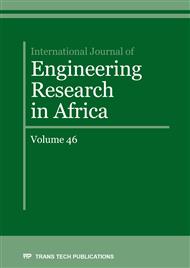[1]
Bayarassou M., 2010. Une approche d'évaluation et d'amélioration du service maintenance basée sur la simulation – Cas de l'entreprise BAG-Batna, Universite Hadj Lakhdar Batna, Faculté des Sciences de l'Ingénieur.
DOI: 10.48087/bjmsra.2014.1203
Google Scholar
[2]
Bounou O., El Barkany A., El Biyaali A., Inventory Models for Spare Parts Management: A Review, International Journal of Engineering Research in Africa, Vol. 28, pp.182-198, (2017).
DOI: 10.4028/www.scientific.net/jera.28.182
Google Scholar
[3]
Diallo C., 2006. Développement d'un modèle d'identification et de gestion des pièces de rechange, Université Laval, Québec, thèse de doctorat.
Google Scholar
[4]
Brezavšček A., 2011. Simple Stochastic Model for Planning the Inventory of Spare Components Subject to Wear-out, Organizacija 44(4), pp.120-127.
DOI: 10.2478/v10051-011-0012-y
Google Scholar
[5]
MohdNoor N., Zaibidi N. Z., Hanafi Z., 2018. An Integration Model of Planned Maintenance and Spare Parts Inventory for Periodic Order Policy, International Journal of Supply Chain Management 7 (1), pp.144-148.
Google Scholar
[6]
Fritzsche R., Lasch R., 2012. An integrated logistics model of spare parts maintenance planning within the aviation industry, World academy of science, engineering and technology.
Google Scholar
[7]
Ayadi I., Bouillant L., Aknin P., Siarry P., 2010. Optimisation par algorithme génétique de la maintenance préventive dans un contexte de modélisation par modèles graphiques probabilistes, institue de la maîtrise des risques, LambdaMu17, 17th Risk control and dependability conference, Rochelle, France.
DOI: 10.4267/2042/56202
Google Scholar
[8]
Subash Babu A., Sanghi U., Ur Rehman A., AL-Shayea A. M., Mohamed A. F. S., 2013. A model to derive software maintenance policy decision, Int. J. Productivity and Quality Management 11(3), pp.247-268.
DOI: 10.1504/ijpqm.2013.052944
Google Scholar
[9]
Smidt-Destombes K.S., Van Der Heijden M. and Van Harten A., 2009. Joint optimisation of spare part inventory, maintenance frequency and repair capacity for k-out-of-N systems, International Journal of Production Economics 118(2), pp.260-268.
DOI: 10.1016/j.ijpe.2008.08.058
Google Scholar
[10]
Wang W., 2011. A joint spare part and maintenance inspection optimization model using the Delay-Time concept, Reliability Engineering and System Safety 96(11), p.1535–1541.
DOI: 10.1016/j.ress.2011.07.004
Google Scholar
[11]
Basten R. J. I., van der Heijden M. C., Schutten J. M. J., Kutanoglu E., 2012. An approximate approach for the joint problem of level of repair analysis and spare parts stocking, ANNE Oper res.
DOI: 10.1007/s10479-012-1188-0
Google Scholar
[12]
Rahimi-Ghahroodi S., Al Hanbali, A., Vliegen, I.M.H., Cohen, M., 2019. Joint optimization of spare parts inventory and service engineers staffing with full backlogging, International Journal of Production Economics, doi: https://doi.org/10.1016/j.ijpe.2019.02.007.
DOI: 10.1016/j.ijpe.2019.02.007
Google Scholar
[13]
Abbou R., Simeu-Abazi Z., Di Mascolo M., 2001. Les réseaux de Pétri pour la modélisation et l'analyse des performances d'un atelier de maintenance, 4e Conférence Francophone de MOdélisation et SIMulation Organisation et Conduite d'Activités dans l'Industrie et les Services, MOSIM'03 – du 23 au 25 avril 2001 - Toulouse (France).
DOI: 10.3166/jesa.38.197-223
Google Scholar
[14]
Bounou O., El Barkany A., El Biyaali A., The performance evaluation of the spare parts management: case study, Management and Production Engineering Review, Vol. 10, No 2, pp.37-49, 2019.
DOI: 10.1155/2020/2950789
Google Scholar
[15]
Labadi K., 2005. Contribution à la modélisation et à l'évaluation de performances des systèmes logistiques à l'aide d'un nouveau modèle de réseaux de pétri stochastiques, Sciences de l'ingénieur, Universités de technologies de Troyes.
DOI: 10.3166/jesa.39.863-886
Google Scholar
[16]
Fattah J., Ezzine L., El Moussami H., Lachhab A., 2016. Analysis of the performance of inventory management systems using the SCOR model and Batch Deterministic and Stochastic Petri Nets, International Journal of Engineering Business Management, Volume 8 p.1–11.
DOI: 10.1177/1847979016678370
Google Scholar


